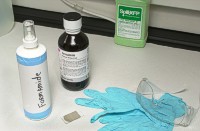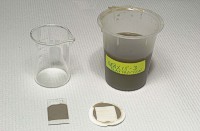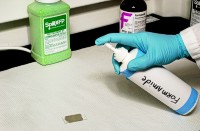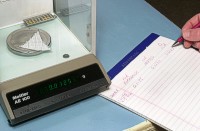 |
A Laboratory Manual for X-Ray Powder Diffraction
Intercalation complexes have long been used to differentiate between the kaolinite and chlorite group minerals and to identify different members of the kaolinite group (Wada, 1961; Wada, 1965; Wada and Yamada, 1968; Range and others, 1968; Calvert, 1984). The method described below, has been modified from Churchman and others (1984), and uses formamide to distinguish kaolinite from halloysite.
Note: Formamide has a health hazard designation of "3" (severe, life threatening). Use formamide only in a fume hood, avoid contact with skin and eyes, and do not breath vapors. Wear gloves, safety glasses, and protective clothing.
| DIFFERENTIATION OF KAOLINITE AND HALLOYSITE BY INTERCALATION WITH FORMAMIDE | |
Materials Required:
|
 |
| Prepare an oriented aggregate mount by the filter-peel technique as described elsewhere in this report, and allow the mount to air-dry. Obtain an X-ray powder diffraction pattern covering the 10- to 7-angstrom region and establishing the background on both sides of these peaks. |  |
| Spray the sample with an aerosol of formamide. Allow the spray to be absorbed for 30 minutes, and obtain another X-ray diffraction pattern of the 10- to 7-angstrom region. If present, halloysite gives rise to a peak at 10.4 angstroms; kaolinite does not expand beyond 7.2 angstroms. Relative proportions of kaolinite and halloysite can be derived from their respective peak areas. |  |
| If the presence of illite is suspected, heat the mount to 110 degrees C for 30 minutes and obtain another X-ray pattern covering the 10- to 7-angstrom region. The heat treatment does not affect the 10-angstrom basal reflection of illite, but causes the halloysite complexed with formamide to collapse to about 7 angstroms. Subtract the area of the 10-angstrom illite peak derived from the heat-treated sample from the area of the 10 angstrom peak derived from the formamide-treated sample. The difference in area is related to halloysite. |  |